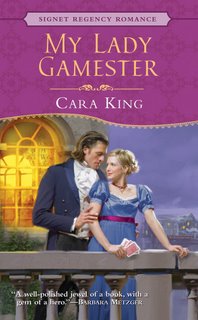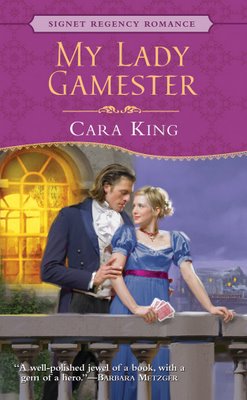 Cara King is a native Californian who has a bad habit of moving every year or two. She has lived in London and Norwich in England, Pittsburgh and Princeton on the East Coast of the United States, and a number of places in Southern California, where she currently lives with her quantum physicist husband and far too many books.
Cara King is a native Californian who has a bad habit of moving every year or two. She has lived in London and Norwich in England, Pittsburgh and Princeton on the East Coast of the United States, and a number of places in Southern California, where she currently lives with her quantum physicist husband and far too many books.
For several years Cara was a film and theater critic for the Goleta VALLEY VOICE in Goleta, California, near Santa Barbara. Cara also writes young adult fiction, science fiction short stories, and children’s fantasy novels. Her hobbies include Regency dancing, Regency card games, reading books, buying way too many books (so she can read them), and acting in community theater productions (particularly Shakespeare, or anything else written before 1910).
Cara’s goals in life include reading all of Shakespeare’s plays, finding somewhere to put all her books, and never reading “Clarissa.” (She is most of the way to the first goal, knows the sun will implode long before she reaches the second goal, and has serious hope of achieving the last goal.)
Learn more at www.caraking.com
 Praise for MY LADY GAMESTER!
Praise for MY LADY GAMESTER!
“A well-polished jewel of a book, with a gem of a hero.” — Barbara Metzger
“This is a touching story. King does a fine job of intertwining Stoke and Atalanta’s lives, as past, present and future become linked forever.”
— Romantic Times Bookclub 4 Stars
“(Cara King) has done her homework on the Regency era and the gambling scene that amused a large part of the ton and ruined not a few. She gives depth to her characters, especially Stoke and Atalanta, who are in for an up and down emotional ride that could end with them as enemies, friends, or more than friends. Neither the serious consequences of gambling addiction nor the tragedies of war are treated lightly, yet MY LADY GAMESTER is a highly entertaining novel. And a remarkable first book.”
— Jane Bower, for Romance Reviews Today
The Interview
Q. How did you think of writing this particular book? Did it start with a character, a setting, or some other element?
It all started with piquet. My husband and I were living in London, and as we knew few people there, we didn’t socialize a lot. And of course, there were only four channels of television! So we read, and we played cards. Piquet is a great two-person card game, and we’d play it at the tiny table in our tiny kitchen, keeping score on a cribbage board. When, a few years later, I was looking for an idea for a new Regency, I thought, “Why don’t I write what I know?”
The entire plot just flowed from there. If there was card playing, then either my hero or heroine needed to be great at cards, right? After thinking, I concluded it would be more unusual — and more interesting — for my heroine to be the expert. Dramatically, of course, she had to play against the hero — who also had to be good. But something more had to be at stake…someone had to want something…and bit by bit, my plot came to me, with that wonderful feeling that of course it had to be like that.
Q. How long did it take? Was this an easy or difficult book to write?
I didn’t write it all in one go — I took breaks, and life intervened (I move a lot, and moving from state to state and country to country takes a ridiculous amount of time, especially if you also have the crazy habit of buying as many books as my husband and I do). It might have taken a year, or thereabouts, in the end.
In a way, it was a difficult book. It was the most intense, most emotional thing I’d ever written, and in ways it demanded more from me than did the more comic novels I’ve written previously.
Q. Tell me more about your characters. What or who inspired them?
I don’t know that they were inspired, exactly…but my heroine did end up with my stubborness. (If you don’t believe me about my stubbornness, just ask my family. They’ll roll their eyes and tell you stories of my pigheadedness!)
Q. Did you run across anything new and unusual while researching this book?
One detail I discovered was that English playing cards during the Regency had plain white backs. I think it’s really interesting that they insisted on that because they thought it made cheating harder, and we use cards with intricately patterned backs for the same reason! Their playing cards also had an up and a down — you could not flip them upside down and have them look the same, as you can with modern cards. In other words, a King of Hearts card only had one head on it!
Q. What do you think is the greatest creative risk you’ve taken in this book? How do you feel about it?
I think my greatest risk was making my heroine so driven and determined. Some might even call her ruthless. I just think she’s interesting!
Q. Is there anything you wanted to include in the book that you (or your CPs or editor) felt was too controversial and left out?
Luckily, no! And I’m quite thankful that that’s the case. If you read a lot of Regencies and historicals that involve gambling, you’ll begin to notice a trend — the actual gambling is usually treated the way sex used to be treated in romances — it’s talked about in the book, it’s important, but anything that actually happens is off-stage. Then afterwards people say things like “that was so amazing” or “I was so shocked” but as readers we’re never allowed to partake in the excitement!
I didn’t want my book to be like that. I wanted the actual gambling drama to come across on the page, the same way it does in Georgette Heyer’s wonderful “Faro’s Daughter.” I spent a lot of time findings ways of getting the action and excitement of the gaming across on the page, without ever confusing readers who might never even have heard of piquet and whist. I had several non-card-players critique the novel at early stages, and they always told me which parts worked for them, and which confused them. My subsequent revisions must have worked, because my wonderful editor never suggested I trim the card playing…and none of the reviewers have complained!
Q.In the course of your research, did you find any real lady gamesters from the period?
Ladies gambled frequently during the period, but they also ran into interesting difficulties. It was thought that if a woman wagered a lot of money on a game, lost, and couldn’t pay what she owed, she would end up sleeping with the man to whom she owed the money in lieu of payment. (And I came across accounts of women who actually did this, too, so it wasn’t just a vicious rumor.) The result of this was that if a woman was known to gamble for high stakes, society tended to question whether she was a “virtuous” woman. I deal with this problem in my book, though it’s not a major issue for my heroine, who cares a lot less about gossip than she does about whatever truth lies behind it.
Q. In many ways, MY LADY GAMESTER is structured more like a suspense novel than like a traditional romance. Why did you make that choice?
Hmm… Let’s just say there are secrets in the book — things Stoke doesn’t know, things Atalanta doesn’t know, and things the reader doesn’t know — so the suspense structure seemed an obvious choice. It helped me keep the tension high throughout the book, and it (surprisingly, perhaps) was a great way to reveal character. (If someone is operating on incomplete information, the assumptions he or she makes reveal a lot!)
Q. What are you working on now?
I’m working on a young adult novel with a paranormal twist, and also a Regency historical. To keep my muse happy, I can’t share too many details of either, except to say that I’ve noticed my heroines in both are quite stubborn — no surprise, I guess!






